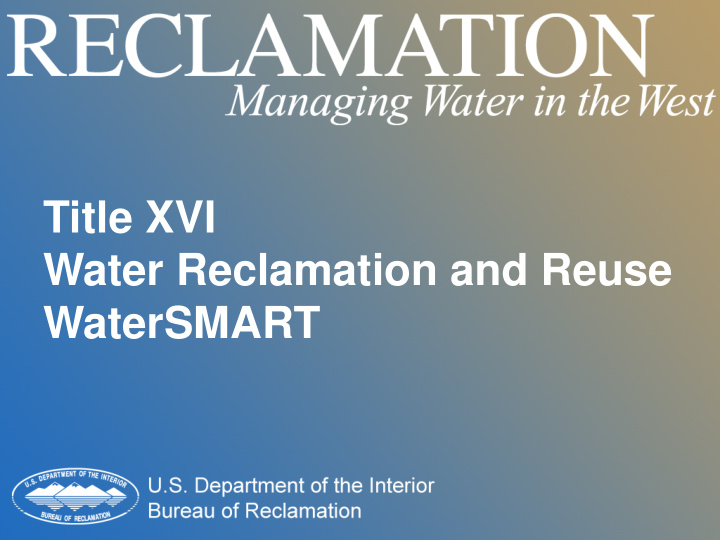



Title XVI Water Reclamation and Reuse WaterSMART
Title XVI United States Department of the Interior Bureau of Reclamation:5 regions for 17 states Mid-Pacific (Sacramento) Pacific Northwest (Boise) Upper Colorado (Salt Lake City) Lower Colorado (Boulder City) Great Plains (Billings) WaterSMART Program Sustain and Manage America’s Resources for Tomorrow http://www.usbr.gov/WaterSMART/title/index.html Funding Opportunity Announcements (FOAs)
Public Law 102-575, as amended Reclamation Wastewater and Groundwater Studies (1992) A program to: 1) Investigate and identify opportunities for reclamation and reuse of municipal, industrial, domestic, and agricultural wastewater, and naturally impaired ground and surface waters, 2) Design and construct demonstration and permanent facilities to reclaim and reuse wastewater, and 3) Conduct research, including desalting, for the reclamation of wastewater and naturally impaired ground and surface waters.
Title XVI: Federal Funding for Feasibility Studies • Federal Cost Share: 50% of the total price • WaterSMART FOA R14AS00030 (www.Grants.gov): • Group I: • Smaller in scope • Up to $150,000 • 18 months to complete • Group II: • Larger in scope • Up to $450,000 • 36 months to complete
Title XVI: Federal Funding for Construction Federal Cost Share: Up to the lesser of 25% of the total cost or $20,000,000, unless directed otherwise by Congress Only for projects specifically-authorized by Congress Only for NEPA-compliant activities WaterSMART FOA R14AS00002 (www.Grants.gov): Up to $4,000,000 per year
Title XVI: Projects and Programs Potential: Consider treated wastewater as an invested resource ready for reuse Projects: Small-scale (115 AFY), local issues and solutions, and one sponsoring agency Programs: Large-scale (3,000 – 40,000 AFY), multiple issues, complex solutions, and multiple sponsoring agencies WaterSMART FOAs: You must tell your own story
Title XVI: Distinguishing Factors Location Upstream or downstream of the Delta Water source Impaired water (salinity, natural, industrial) Treatment technologies Desalination, biological, mechanical, chemical Discharge Ocean outfall, river outfall, spreading ponds Connection to Federal water system Direct or indirect Viability of Storage Better match supply with demand Value of the water used vs the cost of the water Higher-value: agriculture, restoration, industrial offset Lower-value: medians, parks
Title XVI: Potential Benefits Offsetting potable demand Environmental restoration or mitigation Resiliency to impacts of climate change Increased independence from imported water supplies
Mid-Pacific Region’s Contact Nicole S. Johnson Njohnson@usbr.gov (916) 978-5085
Recommend
More recommend